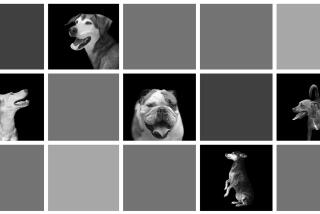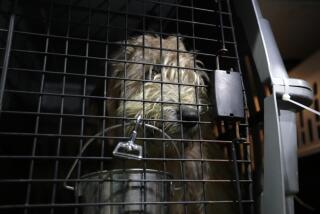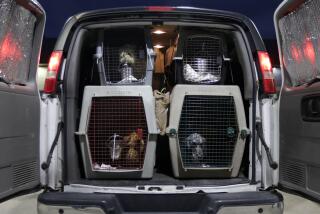A Voice for Those Who Can’t Speak for Themselves
Most of what I write about, I write about with ferocious curiosity and sometimes even zeal, but almost always with a measure of detachment.
Not so this.
I’d already begun writing about https://www.metropettracker.com, a free Web site trying to establish itself as the spot to find lost pets and display found ones across the daunting reaches of L.A. Then someone stole Edgar. Broke into my yard to get him, drove him 15 miles and two cities away, stripped him of collar and tags and dumped him.
I did all the prescribed things, ads and posters with a big reward, shelter searches, to no response. That Edgar was picked up within a day by Pasadena’s animal officers, and that I later found him at their shelter, is a happy chance of incalculable odds. Friends who’d held my hand and assured me that I’d find him confessed afterward, “We never thought you’d find him.”
With 22 animal shelters and even more jurisdictions across the 4,069 square miles in L.A. County, I didn’t think so either. As a county type told me: “An animal control map of L.A. County would look like Middle Europe in the 19th century.”
Beyond the daunting geography, pets--abandoned or lost in earthquakes or fireworks fright--are sometimes rescued by Samaritans who advertise them as found, and then unwittingly turn them over to relieved “owners” who sell them to laboratories for testing, or use them as “blood bait” to train fighting dogs.
No such personal horror prompted Michael Bell and Madeleine Fisher-Kern to dream up the pet tracker Web page, only the relentless daily horror of thousands of animals lost, abandoned, killed in the streets, killed in the crowded shelters.
The site’s multi-service bulletin board is a start, but not until people and shelters can post animals’ descriptions and photos on the Web site, or pets all have microchip implants whose data can be scanned into a computer, will the potential be fully realized. But it may be the one place to find locater maps and contact phone numbers and spay and neuter information and pet-care advice across this map-of-Europe mess called animal care and control.
*
Long before the two of them met, Bell, who does voice-overs for “Rugrats,” had made a dog food commercial addressing an audience of canines, and Fisher-Kern, also a performer, had appeared in a different dog food spot with a poodle mix in the first inter-species commercial smooch.
Years later, at an audition for another commercial, Fisher-Kern met Bell’s wife and the two of them got to talking about the frustrations of rescuing creatures. “All those animals running up and down the street, you try to get them healthy, you try to find them homes, but it’s never solved,” Fisher-Kern says. “In this kind of work, there’s no end in sight, and that’s the tragedy of it, not only for the animals but for the rescuers, who have nothing to keep them going but their own passion. They know the ones they’ve rescued will survive, but they also know there are thousands more out there who won’t. There’s always an irresponsible owner who throws out his cats and dogs unneutered and unspayed. We humans are responsible for the problems we blame on the animals. We’re killing them for our crimes.”
Bell’s frustration, which is that of every animal rescuer, can’t be solved by a Web site. “I’m on the phone two or three times a week. People are looking for a place to put an animal rather than take it to the pound”-- and death roulette.
Every rescuer, knows that, Hydra-like, for every dog or cat rescued, 10 more homeless creatures appear.
Macho owners who want macho dogs, cheapskate owners who won’t spring for surgery, greedy owners who breed puppies as a cash crop, ignorant owners who want their children to see the “miracle of birth” without reckoning the miracle of death--all are guilty of the monstrous animal overpopulation that condemns creatures from the get-go. Bell’s housekeeper had a neighbor who insisted that her dog keep having puppies, until she was shown a video of “surplus” dogs being put to death.
Los Angeles is trying to price owners into spaying and neutering by charging $100 to license an unsterilized dog, but with only two in 10 of the city’s estimated 760,000 dogs licensed now, it is a long shot, and a long reach.
Naturally, in the course of searching for my missing dog, I found another dog, abandoned, sweet-natured, starved for food and affection. That one I could save; I couldn’t do the same for the hundreds of dogs whose cages I had to pass by in search of my Edgar.
*
A kindly friend once told me that rescuers like me reminded him of a story of a little girl on a beach, taking up starfish that had been stranded by the tide and putting them carefully back in deeper waters. A man watching her asked why she bothered, for there were so many, and she could never save them all, and what did it matter?
And the little girl, who never stopped what she was doing, said simply, “It matters to this one . . . and this one . . . and this one . . . . “
*
Patt Morrison’s e-mail address is patt.morrison@latimes.com
More to Read
Sign up for Essential California
The most important California stories and recommendations in your inbox every morning.
You may occasionally receive promotional content from the Los Angeles Times.











